Lecture 5: Linguistics
1/20
Earn XP
Description and Tags
Ch. 9
Name | Mastery | Learn | Test | Matching | Spaced |
|---|
No study sessions yet.
21 Terms
Understand how to interpret a speech spectrogram
A speech spectrogram is a visual representation of speech, showing the energy (amplitude) in low, medium, and high frequencies over time.
Darker areas indicate more energy or louder sounds, while lighter areas indicate less energy or softer sounds.
Key Points:
Word Boundaries: In spoken language, there are often no clear pauses between words, making segmentation difficult if relying on silences alone.
if one tried to segment speech into words by looking for the silences, one would make a lot of mistakes
Phoneme Variability: Speakers vary in pitch and duration when pronouncing phonemes, and pronunciation changes depending on the surrounding phonemes (coarticulation).
Context: Background noise and ambiguity (ex. between "bear" and "bare") are solved by taking the context of the sentence into account
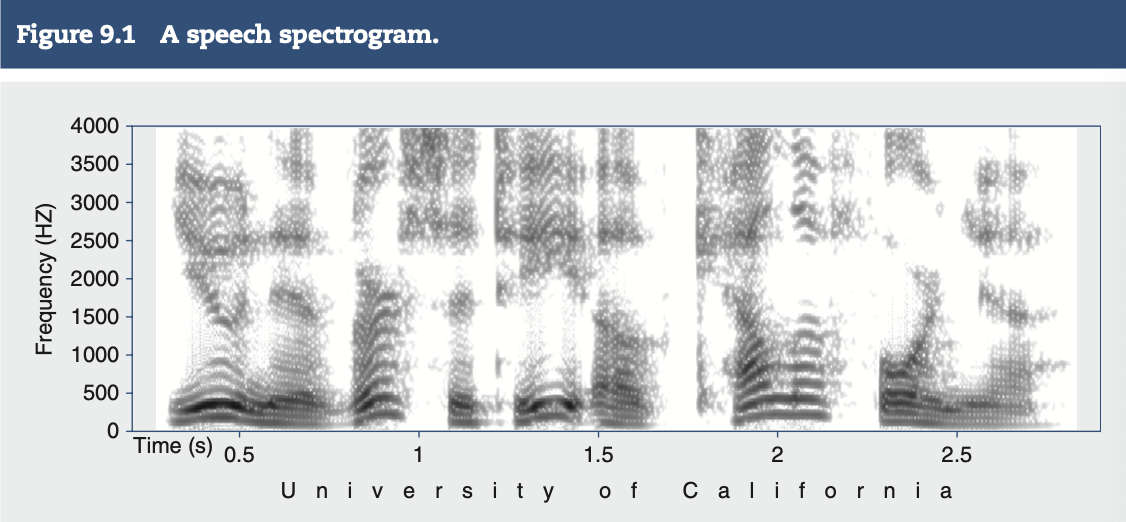
Describe what an image schema is in cognitive linguistics ###
A mental representation or cognitive structure that arises from our sensory and bodily experiences and helps us understand and organize concepts. These schemas are simple, recurring patterns of thought that we use to interpret and make sense of the world.
Explain the negative evidence problem in language learning ##
Questions how children learn the correct rules of a language when they are not given explicit feedback about their mistakes. Despite this lack of direct correction, children acquire language, suggesting that they may rely on innate mechanisms and implicit learning processes to resolve ungrammatical constructions.
What are 5 language properties?
Communicative: production, transmission, and comprehension of information
Arbitrary: The relationship between linguistic symbols (sounds, words, pictures) and what they represent is arbitrary → any sound, picture, word can be chosen to represent a particular thing
ex. “dog” doesn't inherently mean a dog
Structured: Language is governed by a set of rules (grammar) that specify how symbols (words) can be combined. This structure is not random but is organized, with rules governing syntax and word order
ex. “the big house” vs. “la casa grande” → verb placement difference
Generative: A finite set of symbols and grammatical rules can be combined in countless ways to generate an infinite number of sentences and expressions, allowing for creative communication.
Dynamic: Language is dynamic and constantly changing. New words are created, meanings change, and grammatical rules are adjusted over time, reflecting the adaptability of language to new contexts and ideas.
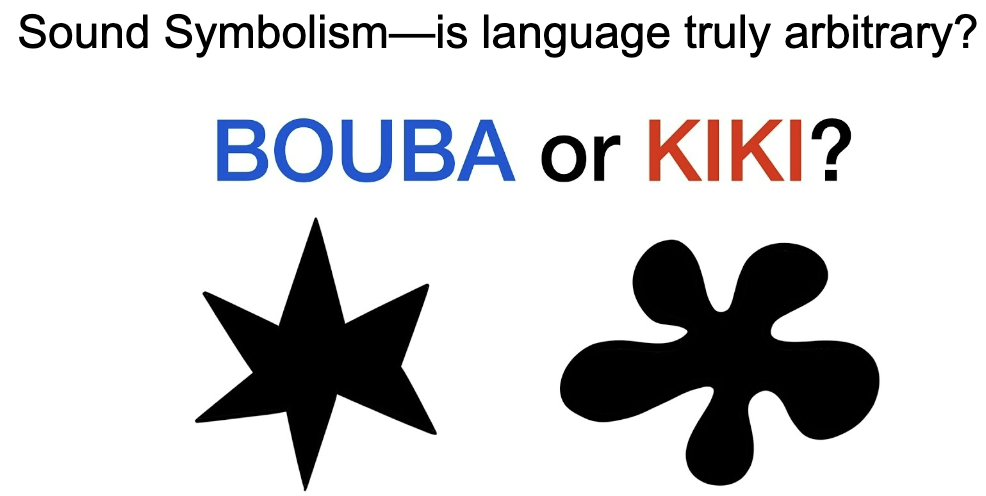
What are 5 grammatical rules of language?
The five grammatical rules of language, which together form its grammar, govern the structure and use of language: increasing in complexity
Phonology: Rules governing sounds
The study of how we produce and perceive individual speech sounds (phonemes)
Morphology: Rules governing word structure
Studies how those meaningless phonemes are combined to make words that have meaning
Syntax: Rules for arranging words in sentences
The study of the structure of sentences, determining the correct word order, and how words combine to create grammatically correct sentences.
Semantics: Rules for understanding meaning (metaphors)
The study of meaning in words, phrases, sentences and how people interpret these meanings.
Pragmatics: Rules for understanding intended meaning
Pragmatics involves understanding the social and contextual meaning of language, taking into account the speaker’s intent and the social context in which the language is used.
What is language processing?
Language processing refers to the way our brain comprehends, produces, and organizes language across different time scales:
Short time scale: Phonology
Medium time scale: Morphology
Long time scale: Syntax, semantics, and pragmatics
Key Components of Language Processing:
Phonemes: The smallest units of speech that do not have meaning. Different phonemes can correspond to the same letter but sound different depending on context (ex. "a" in "father" vs. "a" in "cane").
Morphemes: The smallest units of speech that carry meaning. A morpheme can be a whole word (like "apple") or a word part (like the plural -s in "apples").
the sound of the spoken word apple is a stem morpheme, but the sound of -s denoting the plural form is a bound morpheme because it can only be used when it is bound (or attached) to a stem morpheme, creating apples
What is grammar (syntax)?
Syntax refers to the rules for arranging words in sentences
If there were no rules or constraints on expression, we could string words together in practically any order, and it would be impossible to convey anything.
Key Concepts in Syntax:
Phrase Structure:
Syntax organizes words into larger units called phrases, which form a hierarchical structure.
Each sentence has a distinct organization, with words grouped in ways that follow specific rules, enabling effective communication.
Phrase structure diagrams, often illustrated with syntactic tree diagrams, show how these elements relate to one another within a sentence.
Transformational Grammar:
Developed by Noam Chomsky (1957), transformational grammar explains how sentences can be rearranged or transformed to convey different meanings.
For example, "Jessie drank a cup of coffee" can be transformed into a question: "Did Jessie drink a cup of coffee?" while maintaining the same core meaning.
This transformation highlights the flexibility of language, where new sentence forms can be created while adhering to syntactic rules.
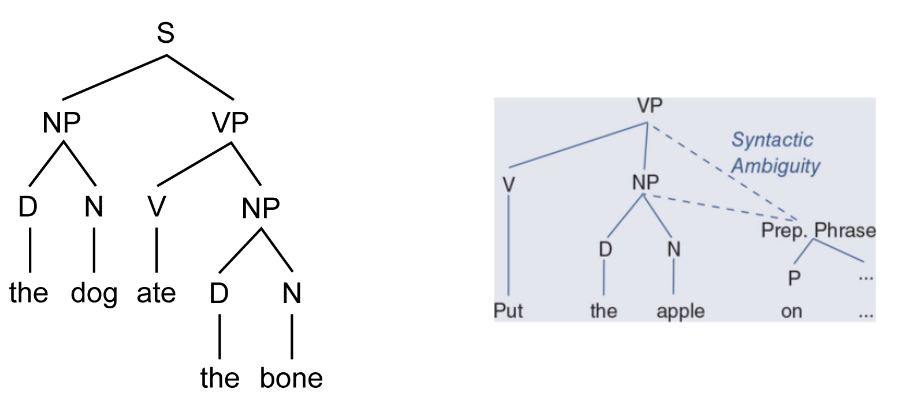
How language shapes the way we think — Lera Boroditsky
Central Idea: Language influences the way we think
Key Quote: "Speakers of different languages think differently"
Examples: an Aboriginal community using cardinal directions like west and east rather than left and right, and the fact that Russian has multiple words for the color blue
What are garden-path sentences?
Garden-path sentences are sentences that initially lead the reader to interpret them in a certain way, but then require the reader to reinterpret the sentence to understand its correct meaning. This causes confusion and forces a mental reanalysis.
Example:
Sentence 1: "The florist sent the flowers smiled."
Readers initially interpret "sent" as the main verb of the sentence, but then encounter "smiled", which forces them to reprocess the sentence to understand it correctly.
Sentence 2: "The florist who was sent the flowers smiled."
This version is unambiguous and clearly shows the intended meaning, avoiding the confusion caused by sentence 1.
Key Point:
Garden-path sentences require more mental effort because the initial interpretation is misleading, forcing the reader to go back and reinterpret the sentence.

What is the Linguistic Relativity Hypothesis?
The Linguistic Relativity Hypothesis, also known as the Sapir-Whorf Hypothesis, suggests that language and thought are closely connected, with two main versions:
Strong Version (Linguistic Determinism):
This version argues that language and thought are so intertwined that it may be impossible to express certain thoughts in one language that originated in another language.
According to this view, language determines thought, limiting the way we think based on the language we speak.
Weak Version (Linguistic Relativity):
This more widely accepted version suggests that language influences thought, but it does not fully determine it.
Different languages may shape how people perceive and think about concepts like time, numbers, and categories (ex. grammatical classifiers), but they do not prevent certain thoughts from being expressed.
Conclusion:
While language influences how we think, it does not completely control or limit our ability to think. Most evidence supports the weak version, indicating that language shapes perception but does not determine it.
What are pragmatics?
Pragmatics: The study of implied and inferred meaning in communication, focusing on how context influences the interpretation of language. It examines the social rules and strategies people use to make their intentions clear, influence others, and achieve specific outcomes without direct commands.
Key component:
Speech Acts: Communicative acts that convey meaning and perform an action:
Assertives: Statements that express the speaker's belief ("Math is hard")
Directives: Instructions or requests aimed at the listener ("Pay attention")
Commissives: Commit the speaker to a later action ("I will read the chapter later")
Expressives: Describe the speaker’s psychological state ("I am sorry")
Declaratives: Spoken statements that are the action ("You are fired")
What are the 4 stages of language acquisition?
Humans pass through several stages while learning a language:
Cooing stage: Begin to utter a wide range of sounds, experimenting with vocalization
Babbling stage: Utter a smaller set of phonemic sounds ("ba-ba" or "da-da”)
One-word stage: Speak out words and morphemes (“milk”)
Two-word stage: Production of two-word sentences (“want juice”)
What are the 3 aspects of Language Learning Theories?
The three aspects of Language Learning Theories explore how humans acquire language, focusing on different types of cognitive mechanisms and the idea of a shared linguistic structure across languages:
Domain-Specific Mechanisms:
These mechanisms are thought to process only linguistic information and are specialized for language learning.
Evidence for Domain-Specific:
Language sophistication: Human language is highly complex and specialized.
Fast learning: Children acquire language rapidly and with little explicit instruction.
Left hemisphere localization: Language processing is often localized in the left hemisphere of the brain.
Infant preference: Babies show a preference for listening to language sounds over other sounds.
Domain-General Mechanisms:
These mechanisms are not limited to language but can process a variety of information, such as visual and linguistic cues.
Evidence for Domain-General:
Statistical learning: Children can pick up patterns in language, like recognizing which sounds frequently co-occur, helping them determine word boundaries and structure.
Universal Grammar:
This theory, proposed by Noam Chomsky, suggests that all languages share a set of core grammatical features and that humans are born with an innate ability to acquire language.
Universal Grammar posits that despite the surface differences in languages, there are underlying universal principles that govern language structure.
Describe universal grammar
Universal Grammar is a theoretical concept proposed by Noam Chomsky, suggesting that humans are born with an innate, hardwired set of grammatical rules that form the foundation for all natural languages. It is the idea that all languages share core properties, and what differentiates languages are variations on these fundamental principles.
Key Aspects of Universal Grammar:
Linguistic Universals: These are rules or structures that are common to all human languages, regardless of cultural or geographical differences.
Universal Properties of Languages:
Phonological Rules:
One common phonological rule is the maximal onset principle, which dictates that consonants typically precede vowels in a syllable structure (ex. "cat" has the onset 'c').
This principle guides how syllables are constructed across languages.
Syntactic Rules:
Word order is another universal property, particularly concerning the arrangement of subject and object in sentences.
In most languages, the subject precedes the object (ex. "John kicked the ball"). This basic sentence structure is a universal feature that varies slightly across languages but follows a consistent pattern.
Chomsky's View:
Chomsky describes Universal Grammar as a "collection of language rules, hardwired into our brains from birth." According to this theory, each language isn't fundamentally different, but rather represents a variation on a shared theme, guided by an underlying universal structure.
Describe Language Deprivation
Language Deprivation refers to the absence of exposure to language during a crucial developmental period, which can lead to significant impairments in language acquisition. This concept highlights the importance of experience in developing language skills.
Key Points:
Critical Period for Language:
The critical period is a specific time in development during which language (or other cognitive skills) must be learned. If linguistic experience is absent during this time, it becomes much harder, or even impossible, to fully acquire language later in life.
This period typically occurs in early childhood, and without exposure to language, children may experience severe and lasting language deficits.
Impact of Deprivation:
If children are deprived of language during this critical period, they may never fully develop language abilities or suffer from severe language impairments.
Case Studies:
Victor, the "wild child": A boy found in the 18th century who had grown up isolated from human contact. Despite attempts to teach him language, he never fully acquired normal language skills.
Genie: A girl discovered in the 1970s who had been severely isolated and deprived of language exposure during her early years. Despite rehabilitation efforts, her language abilities remained profoundly impaired, highlighting the critical period's importance.
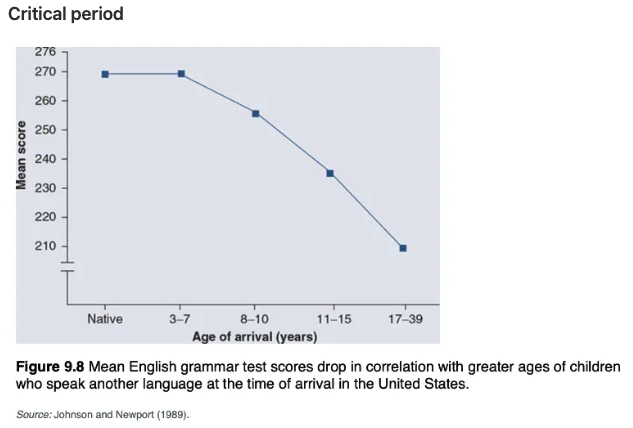
Describe 4 cases of Primate Language Use
Washoe, the chimp, was taught to American Sign Language (ASL)
Koko, the gorilla, was also taught to use American Sign Language (ASL)
Sarah, the chimp, was taught to use plastic tokens
Kanzi, the chimp, was instructed in word-lexigrams
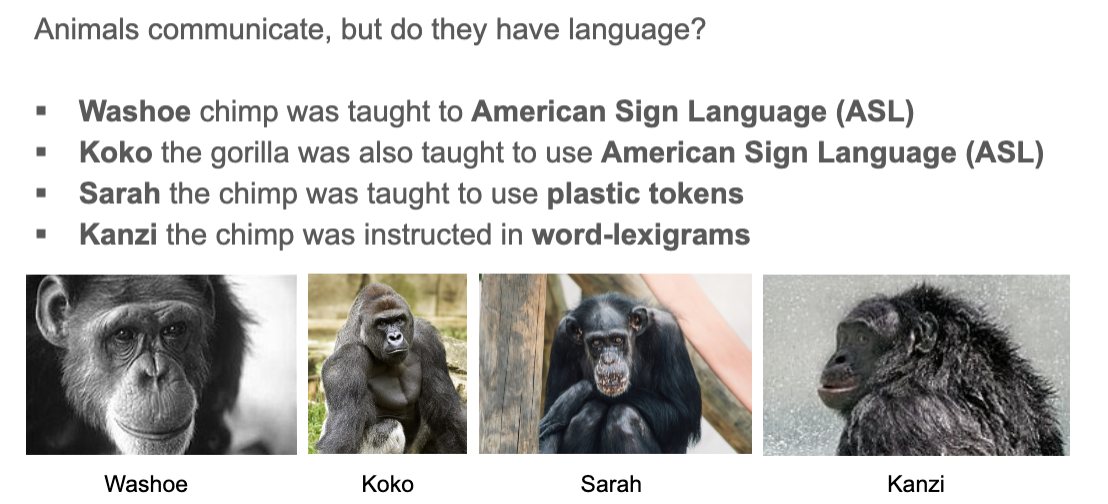
Evaluate primate language use
Primates demonstrate some arbitrariness and displacement, using symbols to refer to objects or events
They fail to show complex syntactical abilities and do not form intricate sentences
They have limited generative capability, unable to create new expressions
They do not teach language to other members of their own
More research is needed to fully understand animal communication
What is Aphasia? What are the two types?
Aphasia is a language disorder caused by brain damage that affects a person's ability to communicate. It can impact speech, comprehension, reading, or writing.
Two Types of Aphasia:
Broca’s Aphasia:
Caused by damage to Broca’s area in the lower left frontal lobe.
Results in difficulty speaking, with slow, effortful speech, but comprehension remains relatively intact.
Wernicke’s Aphasia:
Caused by damage to Wernicke’s area in the posterior portion of the left hemisphere.
Leads to difficulty understanding language, with fluent but often nonsensical speech.
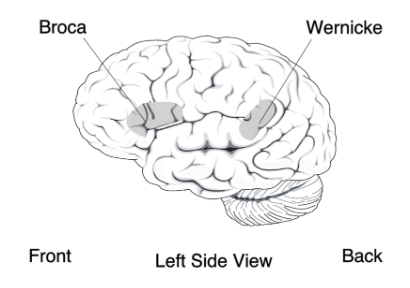
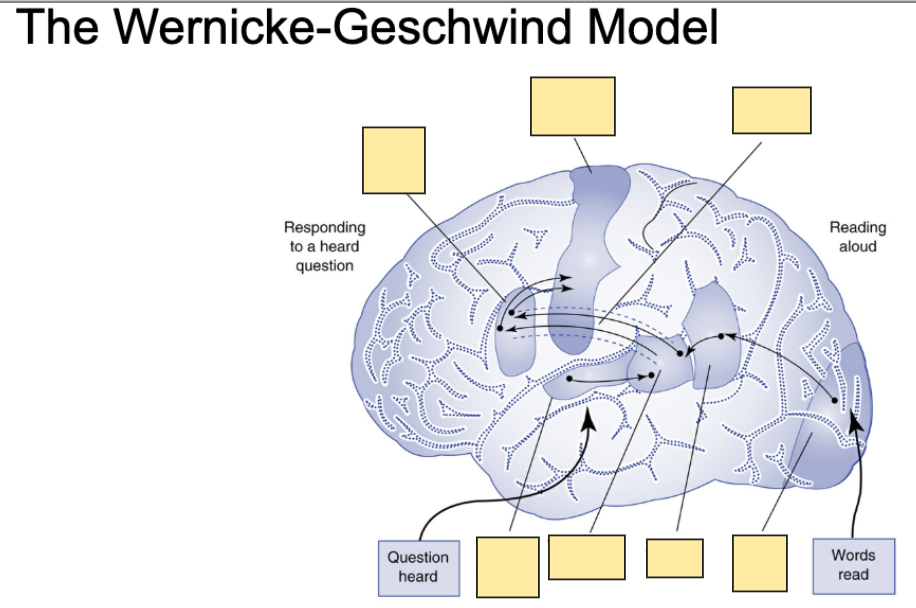
Label the Wernicke-Geschwind Model
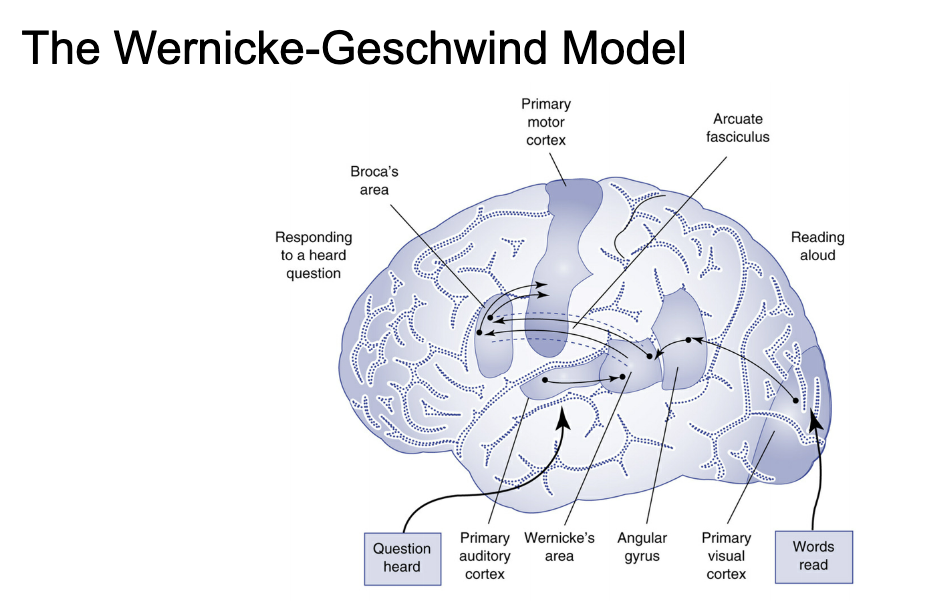
Natural Language Processing
In the field of artificial intelligence, the goal has been to create computer programs capable of comprehending and producing speech. This would enable people to interact with machines more easily.
Comprehension of natural languages in machines occurs in four stages:
Speech recognition
Syntactic analysis
Semantic analysis
Pragmatic analysis
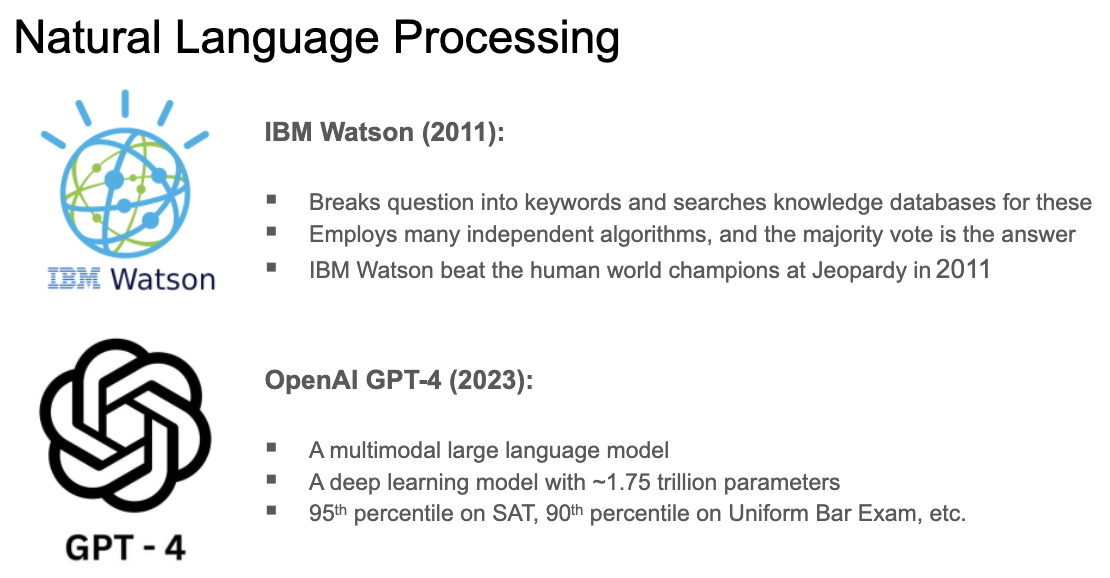
What is speech perception?
Speech perception involves how we hear and interpret speech sounds. It relies on both auditory and visual cues. One example of how speech perception works is the McGurk Effect:
The McGurk Effect shows how visual information, such as lip movements, can affect what we hear. When the brain receives conflicting visual and auditory information (ex. lips forming one sound, but hearing another), it may perceive a third, entirely different sound, demonstrating how vision and hearing interact in speech perception.